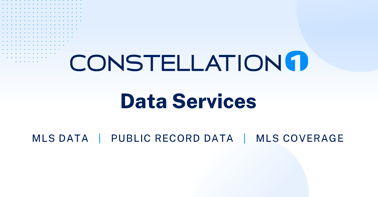Multiple listing services (MLSs) are the foundation of the real estate industry. These organizations are created by and for real estate professionals and provide a range of services that make buying and selling real estate easier. In addition to referring to the organizations themselves, which are also often called associations or boards, MLS is also commonly used to refer to one of the fundamental services they provide: databases of information about properties for sale, also known in the industry as listing information.
Table of Contents
-
Origin and History of Multiple Listing Services
-
How Do Multiple Listing Services Work?
-
How is Data Entered Into the Multiple Listing Service?
-
What is an MLS ID?
-
How Do Property Searches Work in the MLS?
-
What Can Multiple Listing Service Data Be Used For?
-
What Are the Benefits of Multiple Listing Services?
-
How Do I Get Multiple Listing Service Data for my Business?
-
Constellation1 Data Services
Learn More About Constellation1 Data Services
Hundreds of additional technologies and services rely on the data in these MLS databases to help brokers, agents, and customers buy and sell properties, from the websites of giants like Realtor.com to emerging proptech startups.
Learn more about multiple listing services and the data they provide below.
Origin and History of Multiple Listing Services (MLSs)
Multiple listing services have existed in some form for well over a hundred years. According to the National Association of REALTORS® (NAR), in the late 1800s, real estate brokers would gather in person to exchange information about the properties they were trying to sell. They agreed to compensate the brokers who helped sell the properties discussed at these gatherings. These "exchanges" became the precursor to what we now refer to as multiple listing services.
As time went on, these exchanges increased in popularity and became formal organizations. More brokers across the country started to organize this way, forming official associations or boards to manage the exchange of information. We have come a long way since the 1800s. By some estimates, there were as many as 1,400 such regional associations or boards in operation. Today, due to ongoing changes, mostly involving consolidation, the number of MLSs is shrinking. There are currently over 600 MLSs across North America.

While these hundreds of boards and associations were often inspired by or spun off from existing associations, the lack of central governing body meant that they could (and did) do things their own way. The result is a patchwork of rules, practices, and data types that create major headaches when it comes to trying to standardizing listing data from multiple MLSs and display it in one place.
The NAR, which was founded in 1908, has done some work to create standard rules, procedures, and best practices for multiple listing services (see its Handbook on Multiple Listing Policy) to improve data standardization. In an effort to help standardize MLS data even further, in 2002, the NAR officially established the Real Estate Standards Organization (known as RESO, pronounced REE-zo), which was initially a work group that created the first Real Estate Transaction Standard (known as RETS). RETS is no longer in use and has been replaced by the RESO Web API and data dictionary to make it easier to share data among MLSs and with the public.
You can learn more about RESO's efforts and Web API in this informative video:
Due to the decentralized nature of the real estate industry in the United States, there is no single governing body for MLSs and no single way for them to work. However, most MLSs follow a basic model.
Generally speaking, MLSs provide services to their members to facilitate real estate transactions. These services could range from a simple property listing database to a full suite of data services, training, transaction management tools, events, and more.
Brokers and their agents pay monthly or annual dues to join their MLS. In exchange, they get access to the MLS's services, the most important being the MLS listing database. They can add information to it and access the information added by other members, who are fellow brokers and agents in their region.

How is Data Entered Into the MLS?
MLS databases play a key role in every real estate transaction. In order to list a home for sale, an agent must enter that home into the MLS. When an agent or broker logs in, they have the option to add a new listing to the database. A page opens up with all of the fields they need to fill in, Some fields are required while others are optional. These fields including everything a buyer would want to know about a property, from the address, number of bedrooms and bathrooms, and year constructed to the types of appliances, fixtures, and fittings it has, how the property is heated and cooled, details about landscaping, and so much more. Agents can also add special notes that only other agents can see.
It is worth noting that every MLS builds and maintains its own database. This means that every MLS has a unique database structure, unique field names, dropdown choices and ranges, and more. When trying to put data from multiple MLSs together, this can cause major challenges and headaches.

What is an MLS ID?
Once the data entry step is complete and the agent has clicked SUBMIT, the MLS generates an MLS ID for the listing. The MLS ID is one of the most important numbers in every real estate transaction and is used to officially refer to the listing and all associated listing information on transaction documents.
How Do Property Searches Work in the MLS?
The primary audience of the MLS listing database is agents. Agents and brokers display listing information on their websites, on flyers, and sometimes even in storefronts, with the goal of finding a buyer. Likewise, agents representing buyers search the MLS (or help their customers search the MLS) for properties meeting their criteria and budget, then approach the listing agents. Agents can also often see additional information that is not public-facing but that is important to the transaction. To access information about a particular listing, agents enter the property address or MLS ID into the database.
In addition to the databases reserved for agents, some MLSs, like Bright MLS, have consumer facing search options that allow homebuyers to search listings right in the MLS database on their own. Buyers can then contact the listing agent directly or ask their own agent to initiate contact on their behalf.

What Can MLS Data Be Used For?
The data provided by MLSs can be very useful for agents and their brokers. For example, agents use MLS data for the market where a property is located to run comparative market analyses (CMAs) to help their customers determine what a fair or competitive asking price would be. They can also look at the listing and see whether there are contingencies that would affect how or when they make an offer.
Technology vendors may also want access to the treasure trove of MLS data to provide a particular service to real estate professionals or their clients. Data is powerful, so accessing and leveraging MLS data can provide a lot of value for third-party apps and services. To access MLS data, vendors can choose to approach MLSs individually and directly to set up a data sharing agreement, or they can work with a data aggregator like us to set up those agreements and manage those relationships on their behalf.
Benefit 1: Listing Exposure
Perhaps the biggest and most important benefit of multiple listing services is listing exposure. Brokers and agents can rely on the information in the MLS because it is provided by other professionals like them about listings in their local markets. This means more eyes on their listings, so they are likelier to find a qualified buyer sooner.
Benefit 2: Shared Real Estate Commissions
Like the first listing information exchanges that arose in the 1800s, MLSs provide a forum for brokers and agents to share information… and money. Listing agents and buyer agents split commissions on the sale of real estate in large part because of collaboration through multiple listing services.
Benefit 3: Level Playing Field
In multiple listing service databases, it is the listing itself that shines, not a particular broker or agent. This means that both established brokers and agents selling their very first property are on a level playing field, with an equal opportunity to sell their client's property. The market can't be controlled by a single entity, since every MLS member has access to the same reliable listing information.
Benefit 4: Increased Collaboration
MLSs are venues for sharing information. Therefore, it is in everyone's best interest to ensure the information they share is as accurate and up to date as possible. This helps seller and buyer agents work together to make their clients' transaction as smooth and easy as possible, since they both get to share the reward!
Benefit 5: Rules and Best Practices
Multiple listings services are associations by their members and for their members. They set rules regarding what information must be included for every listing and how that information must be displayed, ensuring that everyone has accurate data. Violating these rules can mean disciplinary action, so it is in everyone's best interest to follow them. MLSs also set and encourage their members to follow certain best practices to ensure a consistent level of customer service for all real estate transactions within their purview.
How Do I Get MLS Data For My Business?
If you are a brokerage and you only need access to your own MLS's data, you can arrange a data feed from your MLS fairly easily on your own.
If you are a technology vendor working in a very small market, you might also decide that it's worth your time to get in contact with MLSs and establish and maintain data agreements on your own, too, especially if you have a talented in-house IT team.
The issue many businesses face is that these strategies are not scalable: it is very difficult to establish and maintain separate relationships with 600+ separate entities, each with their own databases, rules, and requirements. It is much faster, and usually much cheaper, to work with an experienced data aggregator that already has relationships with the MLSs you want to work with and for them to manage your data feeds for you.

At Constellation1, we learned how to manage data the hard way.
Over the past 20 years, we learned how to set up and combine feeds from more than 500 MLSs across North America. We honed our expertise cleaning, deduplicating, combining, and synchronizing hundreds of unique data sets for our own use. Over time, we created the center of excellence that has come to be known as Constellation1 Data Services, and what was once solely an internal benefit can now be enjoyed by the entire industry.
For more information about our Data Services, visit our Data Services page.


